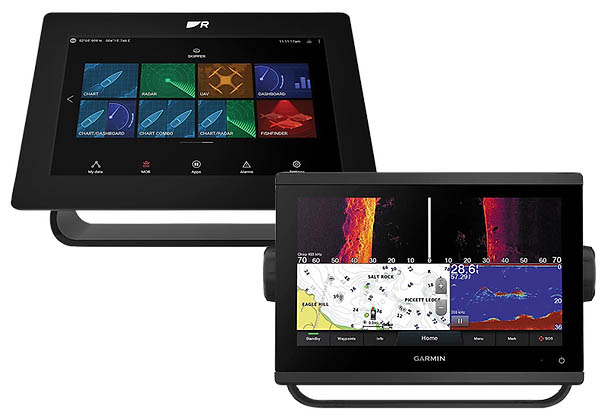A good GPS marine chart plotter will show you where you are located relative to what shows on marine chart data, such as shorelines and marker buoys. A radar ‘paints’ what it actually sees at that moment, such as traffic and temporary obstacles. The importance of both is obvious, so it is not a question of “do I need radar?” but rather “Is radar a practical navigation device for the type of boating that I do?” When you see the quality of the new lower cost products designed for today’s recreational boater, you may well answer this question with a “yes.”
Standard radar operates by shooting rapid microwave pulses of energy. By rotating as it shoots, it will provide a 360 degree picture. Solid objects are identified and positioned on a screen, based upon how much time it takes the pulses to be reflected. Newer “broadband” radars transmit continuous “waves” with increased frequency moving away from the dome, hit a target, and reflect back to the receiver. The difference between frequency in the transmitted and returned waves determines target distance.
Because the Earth’s surface is curved and radar waves travel in a straight line, the height of a radar antenna and the height of the target determine how far your radar can see. For this reason a good antenna height is important. The power of the unit will determine its range. For example, a two kilowatts radar can paint objects 20 miles away, while a four kilowatt unit can reach objects a distance of 32 miles. Such distances are usually sufficient for most yachting activities.
The width of radar wave beams are generally between one degree for the more powerful units and six degrees for the more economical ones. As you would expect, narrower beams with a more focused pulse provide better target differentiation. There are other helpful features to look for with different brands, such as the ability to mark target boats and show their direction and speed. Most new radars today incorporate advanced software that allows you to set your radar to a full-auto mode, eliminating the need for constant tuning and adjustments in addition to the standard features such as alarms and distance settings. The improved sensitivity on these new systems will clearly identify floating objects and small buoys. Another important development is the reduction of power required, as compared to older radars. Many now draw less power than a cell phone, which eliminates the risk of radiation to passengers.
But even with current models you may at first find the ‘paintings’ on your screen, difficult to interpret. I would recommend taking a short course or at least viewing some of the YouTube videos on the subject. Once on the water you should turn on your new radar during day trips and compare what’s on the screen with what you see ahead. This is an excellent way to learn how to interpret the screen and become proficient with your radar.
Today, all electronics manufacturers offer advanced radar systems at prices comparable to what we used to pay for a GPS chart plotter. Garmin’s 40 Watt Gmr 18 HD sells for under $2,000. Navico, the world’s largest marine electronics company, offer the Lowrance 3G and 4G radar models for recreational applications, with up to 36 nm range, high definition target discrimination, instant on, and no radiation – also at affordable prices. Their Simrad division offers the “NSS” combination navigation unit with all of the features mentioned plus a touch screen that allows you to select from a host of different information icons, including chart plotter, depth sounder and radar, and then drag the icon to the main screen for a full view. Raymarine has similar products.
With today’s efficient and affordable menu of radars for recreational boaters, you are going to start seeing more radar antennae on runabouts and center consoles. If you would like to boat more at night, travel new destinations, or just add safety to your cruising, now is the time to look for a radar system that matches your boating needs.







